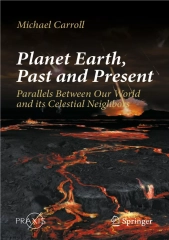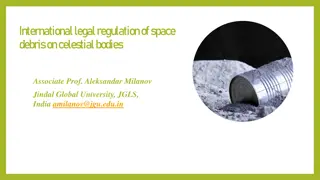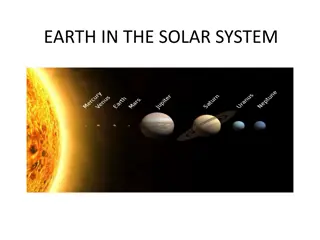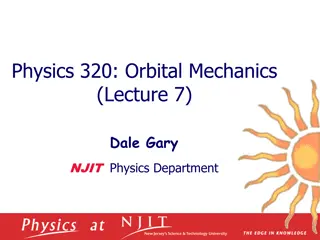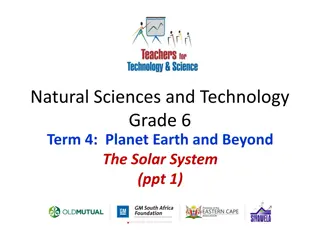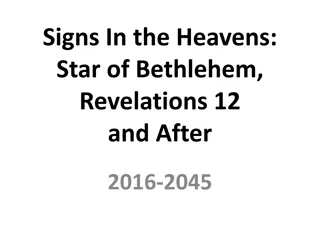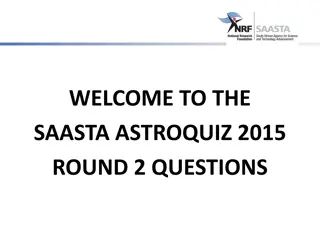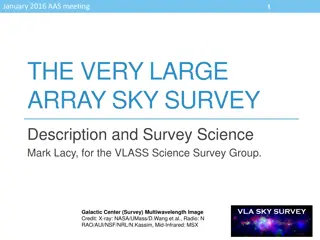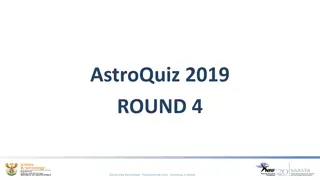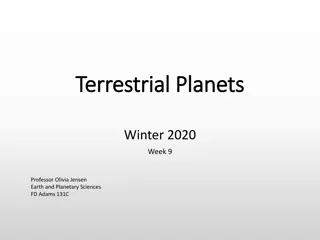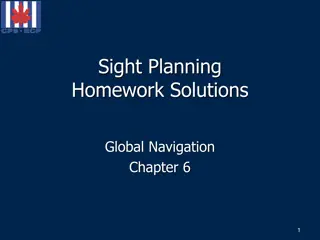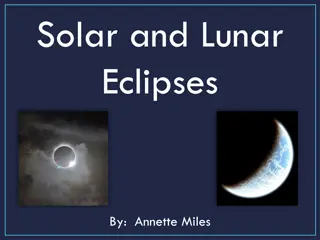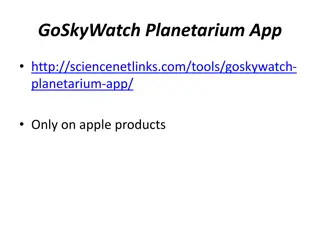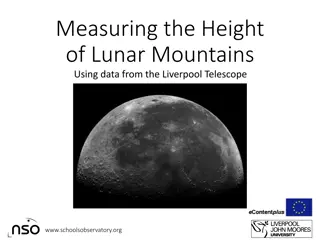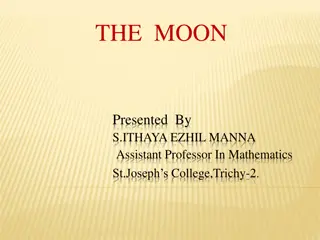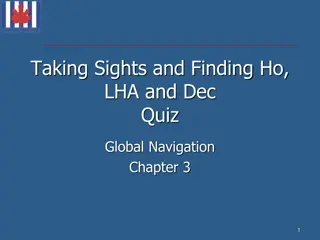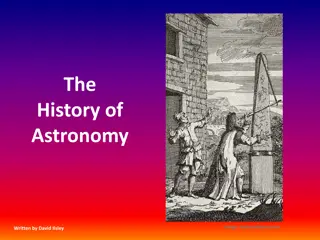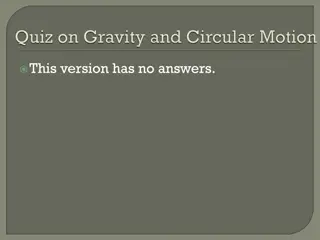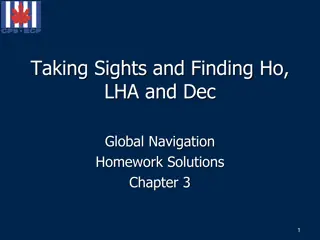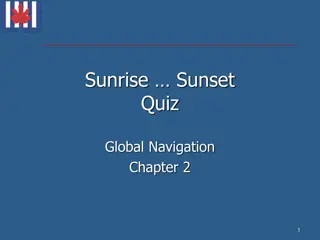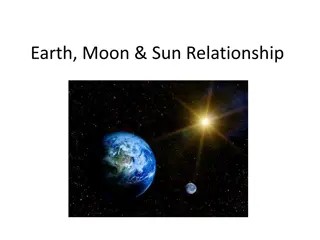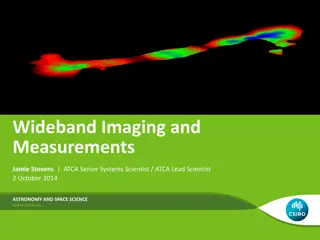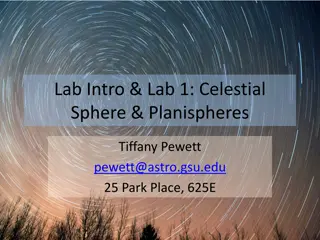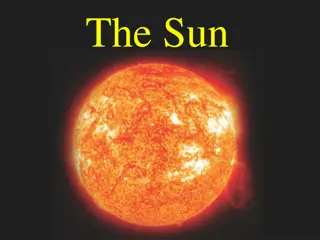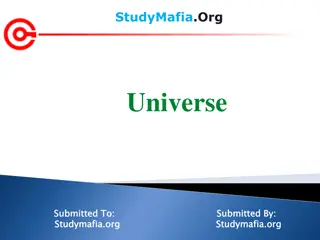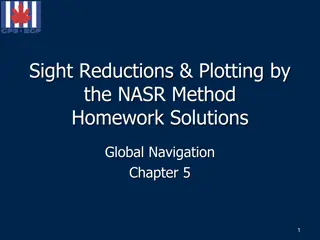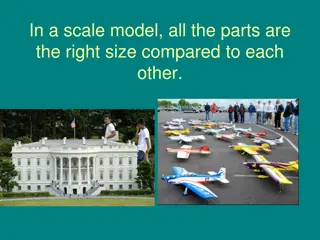PDF_⚡ Planet Earth, Past and Present: Parallels Between Our World and its Celest
\"COPY LINK HERE ; https:\/\/getpdf.readbooks.link\/3031413598\n\nget [PDF] Download Planet Earth, Past and Present: Parallels Between Our World and its Celestial Neighbors (Springer Praxis Books) | Planet Earth, Past and Present: Parallels Between Our World and its Celestial Neighbors (Springer Pra
0 views • 6 slides
Eclipses: The Celestial Dance Between the Sun, Moon, and Earth
Eclipses are fascinating astronomical events where the Moon comes between the Sun and Earth, causing either a solar eclipse or lunar eclipse. This summary delves into the different types of eclipses, such as total and partial solar eclipses, the Moon's elliptical orbit, and the intricate movements t
4 views • 25 slides
Hardware Demonstration and Improvements of the Stellar Positioning System
The Hardware Demonstration and Improvements of the Stellar Positioning System (SPS) involve utilizing ancient celestial navigation techniques for lunar exploration. SPS combines central-body-relative observation with star-field observation to determine absolute position, reducing mass/power impacts
5 views • 14 slides
Ancient Astronomy and Cosmologies Across Different Civilizations
Ancient civilizations like Babylonian, Assyrian, Egyptian, and Chinese had profound knowledge of astronomy, including tracking celestial events, developing calendars, and recording astronomical phenomena. The Greeks contributed to cosmology, contemplating the nature of the cosmos. Beliefs in a spher
2 views • 28 slides
International Legal Regulation of Space Debris and Celestial Bodies Concerns
Space debris on celestial bodies poses environmental risks and challenges in the context of economic resource exploitation. The Artemis Accords and the debate over space resource appropriation raise important legal and environmental issues that require international regulation to prevent degradation
0 views • 10 slides
Orbits and Motion in Astrophysics
Explore the concept of orbits and motion in astrophysics, covering gravitational forces, planetary orbits, orbital speeds, and celestial phenomena like lunar eclipses. Delve into how objects move in space, the relationships between orbital speed, radius, and time period, and the dynamics of celestia
1 views • 14 slides
Celestial Bodies and Constellations in the Universe
Explore the fascinating world of celestial bodies in the universe, including stars, galaxies, planets, and constellations. Learn about the formation of stars, the structure of galaxies like the Milky Way, and how constellations have been observed and named throughout history. Discover the significan
2 views • 28 slides
Ocean Currents: El Niño and La Niña Phenomena
Explore the impacts of El Niño and La Niña phenomena on weather patterns, from unusual warming (El Niño) to cooling (La Niña) of the Pacific Ocean. Discover how these phenomena affect regions like North America, Southern California, and North Carolina, influencing temperature, precipitation, and
0 views • 9 slides
Orbital Mechanics: Kepler's Laws, Center of Mass, and Equation of Motion
Exploring the fundamental concepts in orbital mechanics including Kepler's Laws, center of mass calculations, and equations of motion for celestial bodies. Topics covered include the laws of planetary motion, center of mass reference frame, and the concept of reduced mass in celestial mechanics.
0 views • 15 slides
Exploring the Solar System: The Sun and Beyond
Delve into the fascinating world of our Solar System, focusing on the central star, the Sun. Learn about the different celestial bodies and their composition, with a special emphasis on Earth as a planet. Discover the Sun's characteristics, including its size, temperature, and structure. Explore the
0 views • 7 slides
Signs in the Heavens: The Revelation of the Sign of Yahushua and Biblical Astronomy
Explore the celestial phenomena and biblical interpretations from 2016 to 2045, including the Star of Bethlehem, Revelation 12 prophecy, and the significance of astronomical signs in understanding spiritual truths. Delve into the integration of non-Bible sources like the Book of Jasher and Book of E
0 views • 93 slides
Test Your Knowledge: SAASTA Astroquiz 2015 Round 2 Questions
Explore a set of challenging astronomy questions from the SAASTA Astroquiz 2015 Round 2. Test your understanding of the Sun, stars, and celestial phenomena like solar eclipses. From identifying key solar system components to grasping stellar characteristics, these questions delve into fascinating as
0 views • 44 slides
VLASS Sky Survey and Galactic Science Highlights
The January 2016 AAS meeting discussed the VLASS Sky Survey, highlighting survey parameters, science drivers, and the potential for new discoveries in galactic science. Key topics included multiwavelength imaging, Faraday tomography, AGN and galaxy evolution studies, and the search for exotic system
2 views • 9 slides
AstroQuiz 2019 Round 4 Questions
Test your astronomical knowledge with these challenging questions about planets, stars, and celestial phenomena. From identifying the red planet to understanding equinoxes and the Earth's rotation, see how well you fare in this cosmic quiz!
0 views • 44 slides
Orbital Dynamics: Kepler's Laws and Newtonian Gravity
Delve into the fascinating world of orbital dynamics as we explore Kepler's Laws and Newtonian Gravity. From understanding the elliptical orbits of planets around the Sun to uncovering the role of gravity in shaping celestial motion, this journey will illuminate the fundamental principles governing
0 views • 18 slides
Interfacial Phenomena and Micelle Formation
Interfacial phenomena play a crucial role in the formation of micelles in surfactant solutions, leading to a decrease in surface tension. The critical micelle concentration (CMC) marks the point where micelles first form in the solution. Factors like chain length and electrolytes impact CMC and mice
0 views • 20 slides
Quarkyonic Matter and Chiral Pairing Phenomena
Investigate the characteristics of quarkyonic matter and chiral pairing phenomena in the context of dense QCD at T=0. Delve into the confinement aspects, the properties of quarkyonic matter near T=0, and the candidates for chiral symmetry breaking. Consider the implications of chiral pairing phenome
0 views • 42 slides
Celestial Navigation Chapter 6.1 Homework Solutions
Explore the challenges and solutions to celestial navigation through practical exercises involving star finders, celestial bodies identification, and sight planning tools. Enhance your knowledge of astronomy by setting up tools, locating planets and stars, and mastering the use of templates for plot
0 views • 22 slides
Solar and Lunar Eclipses
Solar and lunar eclipses are celestial phenomena where shadows are cast by one celestial body upon another. A solar eclipse occurs when the Moon blocks the view of the Sun during the new moon phase, while a lunar eclipse happens when the Earth's shadow falls on the Moon. This article explains the di
0 views • 38 slides
Space: Celestial Objects and Beyond
Dive into the wonders of the universe with this engaging lesson on space celestial objects. Discover the differences between comets and asteroids, explore planets and moons in our solar system, learn about stars, asteroids, comets, and galaxies, and unravel the mysteries of astronomy. Let your curio
0 views • 34 slides
Estimating Lunar Mountain Heights with Shadow Lengths
Explore how to estimate the height of lunar mountains by measuring the length of their shadows on the Moon's surface using data from the Liverpool Telescope. Discover the intriguing world of lunar shadows and how they can reveal information about celestial features. See how similar triangles and geo
0 views • 14 slides
The Moon: A Celestial Neighbor
The moon, Earth's closest celestial neighbor, orbits the Earth following Kepler's laws. With a distance of about 240,000 miles and a linear diameter of 2163 miles, the moon's mass is about 1/81 times that of Earth. Learn about the lunar orbit, nodes, and its relationship with synodic and sidereal mo
0 views • 11 slides
Global Navigation Quiz on Sights and Ho Corrections
Test your knowledge with this global navigation quiz focusing on parallax corrections for celestial bodies, GHA calculations, magnitude comparison, and more. Explore questions on lunar altitude corrections, sunrise sighting tips, and atmospheric corrections. Sharpen your celestial navigation skills
0 views • 11 slides
International Laws Regulating Military Activities in Outer Space
The legal advisor, Jean-François Mayence, presented a detailed overview of international regulatory laws concerning military activities in outer space at the International Conference in Bruges, Belgium. The presentation highlighted key treaties such as the 1967 Outer Space Treaty and the 1979 Agree
0 views • 8 slides
The History of Astronomy: From Ancient Wonder to Modern Science
Astronomy, the oldest science, has fascinated humanity for millennia. From early interpretations of celestial bodies as gods to the development of instruments in Mesopotamia to predict events like eclipses, the evolution of astronomy is rich and diverse. Aristotle's theories on the cosmos laid the f
0 views • 25 slides
Analyzing Tallest Mountains in the Solar System
This document explores the tallest mountains in the Solar System and proposes theoretical models for predicting their maximum altitudes on various celestial bodies. It discusses the heights of mountains on Mercury, Earth, Moon, Mars, Vesta, Ceres, Io, and other celestial bodies, along with different
0 views • 29 slides
Concepts in Gravitational Forces and Celestial Bodies
This informative content delves into various concepts related to gravitational forces and interactions between celestial bodies like the Earth and the Moon. It covers topics such as the comparison of gravitational pulls, forces in concentric orbits, weight measurements in different scenarios, and th
0 views • 11 slides
Low-level X-ray Emission of Transitional Pulsars
Delve into the intriguing realm of transitional pulsars emitting low-level X-rays, exploring unique phenomena like pulsations at unprecedentedly low X-ray luminosities, the influence of accretion processes and propeller effects, and potential solutions involving outflows and the location of the magn
0 views • 17 slides
Celestial Navigation Homework Solutions Chapter 3.1 - Taking Sights and Finding Ho, LHA, and Dec
Demonstrate and describe techniques for taking sights on moon, planets, and stars. Apply proper altitude corrections to determine Ho, compute LHA and Dec for each sextant observation, understand and apply celestial coordinates.
0 views • 16 slides
Mysteries of Space Rocks: Questions and Answers
Explore the intriguing world of asteroids and comets with these thought-provoking questions and answers. Learn about the frequency of impact events, the targets of celestial debris, and the history of asteroid collisions with planets. Delve into meteorites, meteors, and the fascinating phenomena ass
0 views • 45 slides
Global Navigation: Sunrise Sunset Quiz Chapter 2.1 Solutions
In this chapter, the solutions to various navigation problems related to sunrise, sunset, time zones, and celestial calculations are discussed. The solutions cover scenarios such as determining ZT based on given LMT and coordinates, calculating morning NT, finding ZT for morning CT, and understandin
0 views • 10 slides
The Amazing Relationship Between Earth, Moon, and Sun
Explore the intricate relationship between Earth, the Moon, and the Sun through topics like rotation, revolution, seasonal changes, moon phases, and the characteristics of each celestial body. Uncover the wonders of our solar system and how these three entities interact to create the phenomena we ob
0 views • 12 slides
Wideband Imaging and Measurements in Astronomy
Wideband imaging and measurements play a crucial role in astronomy and space science. This involves utilizing wide bandwidths to make accurate measurements and create images for continuum mapping and spectral-line observations. Increasing bandwidth enables lower thermal noise levels, quicker identif
0 views • 32 slides
Unveiling the Mystery of SN 1054: A Historical Investigation
Delve into the intriguing historical background surrounding SN 1054, exploring events such as total solar eclipses, numismatic evidences, and celestial phenomena witnessed in 1054. Discover the scholarly works of Prof. Ruffini and the studies on Alexius Comnenus I as you unravel the historical signi
0 views • 18 slides
Astronomy Lab Information and Schedule
In this astronomy lab course, students will explore various topics related to celestial objects, constellations, planispheres, and observational projects. The labs involve practical activities such as observing the phases of the Moon, visiting observatories, and understanding celestial coordinates.
1 views • 12 slides
Exploring the Structure and Phenomena of the Sun
Discover the intricate balance and core structure of the Sun, maintained by hydrostatic equilibrium. Energy moves through radiation and convection zones, with convection manifesting as granulation on the photosphere. Eclipses, such as solar eclipses, provide unique opportunities to witness celestial
0 views • 12 slides
Universe: An Exploration of Celestial Bodies
Scientists study the vast expanse of the universe, birthed from the Big Bang, where stars, galaxies, and constellations exist. Exploring celestial bodies like stars, planets, and moons reveals the wonders of our universe.
0 views • 20 slides
Celestial Navigation: NASR Method Homework Solutions
Calculate altitudes, intercepts, and azimuths of celestial bodies using the NASR method. Plot celestial lines of position (LOPs) and fixes based on sights taken on the sun, moon, planets, or stars. Explore comparisons between the Law of Cosines and NASR methods for sight reduction. Practice plotting
0 views • 5 slides
Scale Models of Celestial Bodies
Scale models provide insights into the relative sizes and distances of celestial objects like the Earth, Sun, and Moon. Discover how these models help visualize the vast scales of our universe.
0 views • 13 slides
The Outer Space
Delve into the wonders of the universe from the vast expanse of outer space to the intricate details of planets and celestial objects. Discover the beauty and mysteries of galaxies, the solar system, planets like Earth and Mars, as well as celestial bodies such as the Moon, stars, comets, and astero
0 views • 25 slides
